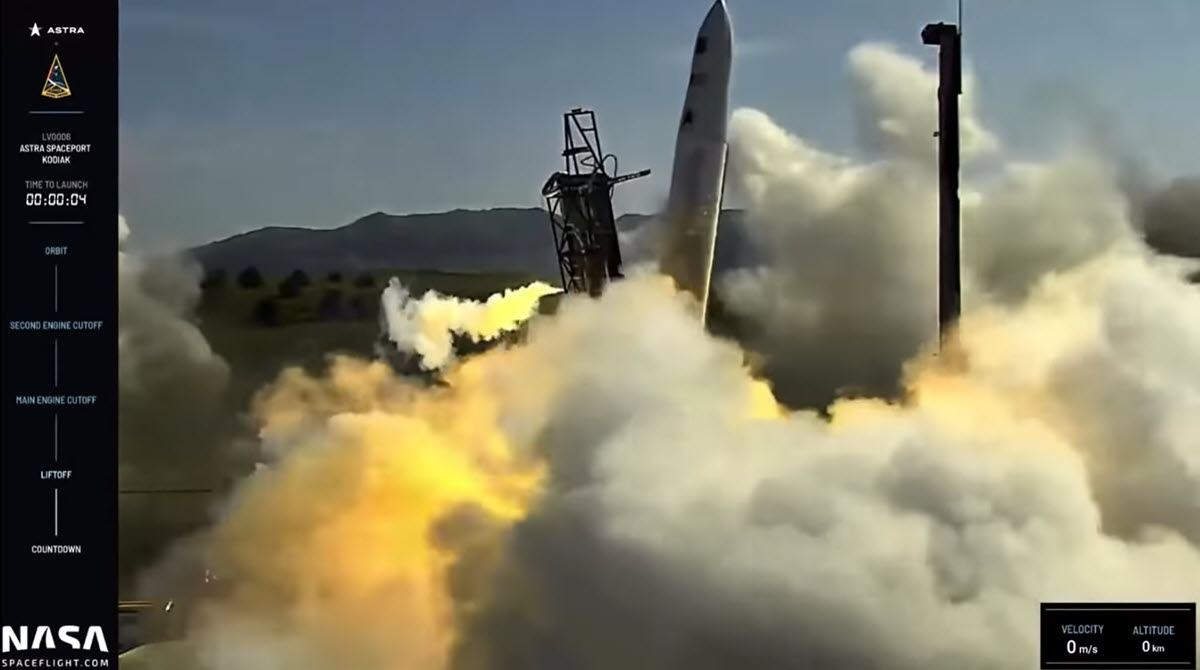Astra rocket moves sideways, but takes off anyway
The space startup Astra failed in its third attempt to launch its small rocket into orbit. After a startling phase, the attempt was stopped after 2.5 minutes.
On Sunday night at 12:35 a.m. Central European Time, Astra took off from the Pacific Spaceport Complex on Kodiak Island in Alaska on its third orbital test flight. The two-stage launch vehicle 0006 from the Rocket 3.3 model series was used. The rocket, which is only 13 meters high, was equipped with a test payload for the space test program of the US Department of Defense. This payload was the shape and weight of a conventional satellite, but was not intended to be deployed in orbit.
Contents
Astra satisfied despite a false start
The start turned out to be unsuccessful in the end, but it was particularly spectacular. Because the rocket tilted slightly immediately after the engines started, but then caught itself again and initially moved sideways for about 15 seconds before it rose again.
After 2.5 minutes, the start attempt at “Max Q” was ended. This is the point at which the mechanical stress on a missile is highest. A camera attached to the rocket showed that part of the booster had come loose at this point at an altitude of around 50 kilometers.
Astra is still not dissatisfied. Despite the failure, they were able to collect a lot of data and get out of the trial without any significant damage to property, as Astra boss Chris Kemp did after the failed attempt in a press release confirmed.
Initial analyzes showed that one of the rocket’s five engines in the first stage failed about a second after takeoff for unclear reasons, the co-founder of the Spacetech startup said in a tweet.
Data should show where the problem was
The rocket was then brought into the air by the remaining four engines alone. To do this, however, it first had to use some fuel in order to be light enough not to need the fifth engine any more. After 2 minutes and 28 seconds, the order to switch off all engines came from the launch pad, according to Kemp. Now it has to be determined where and when exactly which problems have occurred before a new start date can be scheduled.
The start had already been postponed from last Friday to Sunday night because the launch vehicle control system had reported an abort shortly after the engine had been ignited. However, the problem soon turned out to be a configuration error in the engine, so that nothing seemed to stand in the way of a quick alternative appointment.
Astra, which was founded in 2016, aims to capture a large share of the growing market for small satellite launches with its mass-produced, cost-effective and constantly evolving rockets. The company’s launch system is designed to be extremely mobile and flexible. For example, the rockets are transported to the launch site in standard containers.
“In many ways, the technology that goes into a car is more complex than that in a missile. But they are able to build cars for a few tens of thousands of dollars, ”said Astra CTO Adam London in an interview on the company website. Nowadays there are still no rockets that are as affordable as a car. Astra wants to close this gap.
Astra has already made two test flights without a payload in Earth orbit. In September 2020, the company’s 3.1 rocket had a steering problem shortly after launch and crashed back to Earth. Rocket 3.2 successfully entered space in December of that year, but ran out of fuel just before it reached orbital velocity. With the new launch vehicle variant 3.3, Astra wants to have solved the problem of fuel consumption and improved the performance of the upper stage. The new model is one and a half meters higher than its predecessor.
The company’s goals are ambitious. Due to the extremely low prices and the high modularity of its rockets, Astra ultimately wants to get into the situation of carrying out daily satellite launches. London sees huge potential in this. “If you have a satellite in orbit and it fails, you have to quickly bring another one back there,” he says, adding: “If you want to launch a constellation of thousands of satellites, you don’t want to wait six months between launches . Our idea is to bring a few satellites to exactly where they are needed almost every day so that a constellation can be set up in one or two years instead of five years. “
Astra’s order books are well filled. The company has signed contracts for more than 50 launches, which together add up to more than $ 150 million in revenue, Kemp told Space magazine last month Space.
Astra Space Inc. became the first space company on July 1, 2021 on the New York Nasdaq written down. The IPO took place through the takeover of the already listed SPAC Holicity Inc.



